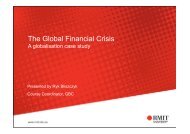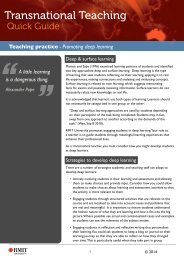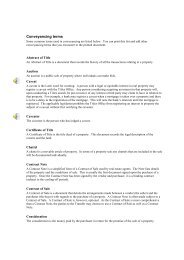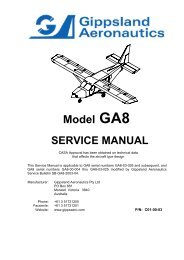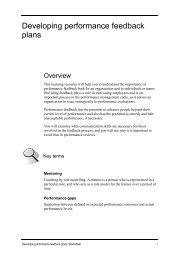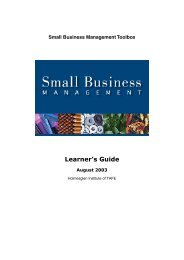Conduct exit interviews worksheet - Flexible Learning Toolboxes
Conduct exit interviews worksheet - Flexible Learning Toolboxes
Conduct exit interviews worksheet - Flexible Learning Toolboxes
You also want an ePaper? Increase the reach of your titles
YUMPU automatically turns print PDFs into web optimized ePapers that Google loves.
<strong>Conduct</strong> <strong>exit</strong> <strong>interviews</strong>OverviewIt is essential that the <strong>exit</strong> interview be well-planned, conducted properlyand that extensive notes are taken. This will ensure that all areas arecovered for the <strong>exit</strong>ing employee and that the likelihood for a dispute lateron is severely diminished. Information gathered in the <strong>exit</strong> interview canalso be used as feedback on how the organisation can improve its processesand procedures. This resource demonstrates how to plan and conduct an<strong>exit</strong> interview and how feedback can be used and evaluated.Key termsDeparture PackageThis is similar to the orientation package given to new employees. It mayinclude advice on superannuation, tax forms for the employee and a guideas to the employee’s options.EISExit interviewing and surveying (EIS) is a process used for gatheringinformation from departing employees.OutplacementA service to guide a terminated employee of a company to a satisfactorynew position or career through the provision of short- or long-termcounselling and support services. This can be on a group or individual basisand is most often paid for by the terminating employer.<strong>Conduct</strong> <strong>exit</strong> <strong>interviews</strong>: Worksheet 12002_329_026 July 2003
Exit <strong>interviews</strong> and surveysThe last task in the separation/termination process is the <strong>exit</strong> interview.There are two main reasons for holding <strong>exit</strong> <strong>interviews</strong>:• To foresee potential problems with a departing employee before thesituation gets out of control.• To provide information that could be used to improve processes andprocedures in the organisation.Exit <strong>interviews</strong> can take the form of• a dialogue between the employee and the appropriate manager• a survey form• a combination of both.Exit interviewing and surveying (EIS) is a process used for gatheringinformation from departing employees. It is a chance to:• collect any documents you gave the employee to read and sign whennotice was given• give the employee any additional documents (such as a cheque)• gather any information from the employee.The interview may take a variety of forms. For some people it can be anencounter, for others just a chat. The agenda, tone, participants andprocesses will vary depending on the type of change the employee faces.Through EIS, data can be gathered to provide feedback that can be used toimprove the organisation for those who are still working there and thosewho will join later. The EIS process covers such issues as:• working conditions• opportunities for career advancement• the quality and quantity of work• relationships with co-workers or supervisors.An EIS must:• have sound methodology• be responsive to your organisation’s identifiable purpose• be designed to assess specific problems and identify newopportunities.• At the end of this document are several examples of possible ExitInterview forms.2 <strong>Conduct</strong> <strong>exit</strong> <strong>interviews</strong>: Worksheet2002_329_026 July 2003
Issues and concernsMany problems associated with <strong>exit</strong> interviewing and surveying (EIS) canbe traced to the lack of clarity about the EIS process itself. EIS mechanismsthat have lacked a clear purpose were unable to fulfil vague expectations. Sohow do you avoid the confusion?One effective way is to ensure the questions in the EIS reflect the companymission statement or policy. If your organisation prides itself as a ‘familyfriendly’workplace, then test how well that policy is applied in practicewith your questions.If your organisation promotes itself as ‘innovative’, then use the EIS tosurvey how well innovation and ideas are encouraged amongst employees.Studies show that the <strong>exit</strong> interview is subject to some degree ofinformation distortion, particularly if conducted by management at the timeof separation. This is due to• the departing employee fearing distortion from the interviewer thatcould reflect poorly on a future career, or fearing that negativeinformation from the manager may reach a new employer• the employee finding the interview too personal, or believing that themanager conducting the <strong>exit</strong> interview doesn’t care about them or theinterview• the employee believing that information given to the interviewer couldlead to problems for other people in their workgroup• <strong>exit</strong>ing staff not wanting to discuss uncomfortable issues• emotions—if the employee is terminated summarily.Employees who have had an <strong>exit</strong> interview have also been critical about theprocess, claiming that the interview• didn’t cover the right questions• was slanted towards trying to talk them out of leaving, rather than tryingto find out why they wanted to leave.TipIt is important to keep records during the <strong>exit</strong> interview as these willserve as evidence that you complied with your obligations on behalf ofthe organisation if the separation / termination is later disputed.<strong>Conduct</strong> <strong>exit</strong> <strong>interviews</strong>: Worksheet 32002_329_026 July 2003
ThinkHave you ever participated in or observed an <strong>exit</strong> interview? If so, whathappened? In your opinion, was it handled well, both from the perspectiveof the person conducting the interview and the employee being interviewed?Consulting stakeholdersBefore the day arranged for the interview arrives, you must consult withother people who have a stake in the outcome. These may include employeerepresentatives, the departmental manager, HR staff, or governmentdepartments such as Centrelink.A departing employee’s supervisor should be consulted before an <strong>exit</strong>interview. Together, you can work out the most important questions to ask.Information you might want to find out from the supervisor may include:1. What specific confidential information did the employee have accessto?2. Are there any documents, notes, equipment, notebook computers,etc. that the employee has not returned?3. What projects did the employee work on? Is the employee workingon a project that requires their continued employment orconsultation?4. Will the employee’s resignation cause any difficulties to thecompany?5. What was the attitude of the employee?6. Was the employee taking home more work than usual?7. Did the employee request to take any documents home?8. Did the employee use photocopy equipment more than usual?9. Did the employee work evenings, weekends or other times whenother employees weren’t present?10. What was the personality, behaviour, etc., of the employee? Thisinformation may help you work out strategies for handling theinterview.4 <strong>Conduct</strong> <strong>exit</strong> <strong>interviews</strong>: Worksheet2002_329_026 July 2003
The answers to these questions will help you prepare an appropriate <strong>exit</strong>interview and highlight any areas that might cause potential problems ortension during the actual interview itself.Who should attend?When firing an employee, always have one other person present to reducethe possibility of a misunderstanding turning into an argument later on. Thethird person serves as a witness. In general, though you should invite thefollowing people to an <strong>exit</strong> interview:• the interviewer• the employee• the interviewer’s witness—preferably another manager or a secretary totake notes• the employee’s witness. You must ask the employee if they wish to havea witness present. This could be a union representative if it’s a unionisedworkforce. (But do this diplomatically so the employee won’t think youare going to accuse them of some ‘crime’.)Who should conduct the interview?The obvious candidates to hold <strong>interviews</strong> are professional HR staff, but ifpolicy doesn’t allow that or there isn’t an HR department, try to arrange forone of the people who appointed the employee to conduct the interview.Another alternative is an outplacement consultant.Whoever you decide on, the interviewer should be someone with training inthe procedures and experience in the process. The immediate supervisor ormanager is not always the right person to conduct an <strong>exit</strong> interview. If asenior staff member is leaving, the interviewer should be someone whosestanding in the company reflects the person’s experience.When should the interview be held?In most cases, the interview should be conducted some time betweennotification of departure or termination and the actual date of leaving,preferably not on the last day.In some cases, for example when payment instead of notification is planned,there is little time for you to get everyone concerned ready for the interview.You may consider holding the interview mid-afternoon, as that avoids:<strong>Conduct</strong> <strong>exit</strong> <strong>interviews</strong>: Worksheet 52002_329_026 July 2003
• an unseemly rush at the end of the day• the employee spending too much time for the rest of the daydiscussing the interview with others in the workplace.In the case of a number of staff finishing due to redundancy, or people inmore than one location, your objective should be to interview everyone assoon as possible, on the same day, in the same timeframe. As this will take anumber of interviewers, they must be thoroughly briefed.Where should the interview be held?The ideal place is in a room designed for <strong>interviews</strong> or meetings. As with atermination, you will ideally avoid holding this private discussion at theworkstation, or in the department manager’s office.If no place in your organisation is designed as an interview room, then an<strong>exit</strong> interview can comfortably be held in a neutral office that you borrowfor the occasion.Don’t forget to book the room! There should be no phones in the room anda ‘do not interrupt’ sign on the door.How should participants be notified?This is a meeting, so it deserves a written agenda that is given to allparticipants in time for them to prepare for their contribution to theoutcomes. The agenda will normally specify who is coming to the meeting,where it will be held, the time, the reason for the meeting and the topics tobe discussed.You should also send details of the employee’s end date to other relevantparticipants. Include details such as:• the payroll section, so they can have the cheque prepared• the IT department, so they know when to delete access to company files• security, so they can know when to collect keys, etc.This is especially important in the case of redundancies when a number ofpeople are being terminated. Also it might be a good idea to have a checklistof such things as company property to tick off.6 <strong>Conduct</strong> <strong>exit</strong> <strong>interviews</strong>: Worksheet2002_329_026 July 2003
ResearchDoes your organization have a standard <strong>exit</strong> interview procedure forthe following situations: resignation, retirement, redundancy,redeployment, or termination? If so, what form does that procedure take?Is there a face-to-face interview, a survey, a combination of both, or someother procedure?Separation/termination checklistNo matter how well the interviewer has been trained, it is all too easy toforget important information in the exchange. It’s not uncommon that stepsin the process are overlooked and that what is said is not accuratelyrecorded. To be sure that all the key questions are answered and that provenprocedures are followed, a standard checklist should be in place, ready foruse before it is needed.This document can be in the form of a formula, a guide, a survey or achecklist. As topics are addressed during the interview, they are marked off,comments added and the finished document can then serve as a record ofinterview.As the interview proceeds, the interviewer can use the checklist to collateand sort the information for:• improvement of operational effectiveness and healthier productivityin the organisation• straightforward gathering of explanations and remarks from thedeparting employees, enabling easier interpretation• particulars on how the employees perceive the– work environment– management effectiveness– work conditions and procedures– organisation’s strengths and weaknesses– compensation/benefits– safety<strong>Conduct</strong> <strong>exit</strong> <strong>interviews</strong>: Worksheet 92002_329_026 July 2003
• notification of possible problem areas within specific departments.Management and HR will then discuss how to best use this information forretention of good employees, recruitment of future staff, cost control andevaluation of company processes.Items on your checklist should include the following:• An agenda for the <strong>exit</strong> interview• A list of all who should be present at the interview• A list of any company property that should be returned• The notice of termination (if applicable). Note: Be careful of whatyou put in writing. Some HR practitioners give the employee twocopies to take away, asking them to sign them and return one whenthey’ve had time to read it through properly (usually at the <strong>exit</strong>interview).• A departure package (similar to the orientation package given tonew employees). That package may include advice onsuperannuation, tax forms for the employee and a guide as to theoptions faced.• Contact details for your outplacement agency (where applicable).• Someone who takes extensive notes of the <strong>exit</strong> interview throughoutInterview techniquesThe following are interviewing strategies that are designed to help establishthe goals discussed earlier, while decreasing the employee’s resistance todisclosing information.Table 2: Interview techniques and tips (2 cols)TechniqueAsk open-endedquestions.Ask—don’t tell.Use reflectivelistening.TipAvoid using questions that will elicit a short answer (e.g.,‘Tell me more about these difficulties’ as opposed to‘Have you had difficulties with this?’)Spend far more time listening than you do talking. Allowthe person to do most of the talking. (Aim for a 70/30listening to talking ratio).Look for the underlying meaning of what is being saidand reflect this back to the person. Focus on how theperson is feeling.10 <strong>Conduct</strong> <strong>exit</strong> <strong>interviews</strong>: Worksheet2002_329_026 July 2003
TechniqueUse doublesidedreflection.Summarise.Affirm.TipUse two-sided reflections in order to highlightambivalence. For example, ‘So, on the one hand, you saysmoking outside the building makes you feel morerelaxed, but on the other hand, you know that it upsetsyour workmates, that you disappear for so long.’Summarise key statements. Connect motivationallyrelevant material, allowing the individuals to hear theirown words and thoughts again.Create the sense that you are supportive. Reinforceimportant statements with reflective listening andsupport, as well as nods.What to avoid in discussionsThe following are some suggestions about what to avoid during aninterview. In general, these things are likely to increase a person’sresistance and to create discomfort and poor rapport.Table 3: What to avoid during an interview (2 cols)Poor techniqueThe question –answer routineConfrontation –denialThe expert trapLabellingReasonsUnless you are simply filling in an <strong>exit</strong> survey form,try to avoid asking a series of questions that demandshort answers. This prevents elaboration andexploration.Confronting someone, by nature, almost demandsthat they will insist on the opposite perspective.Avoid arguments, ego struggles, or debates withsomeone about what they should do.If you seem like you have all the answers, the personyou are talking to will fall into a passive role andwill not work on their own to explore and resolveany ambivalence about the nearing departure.Many labels (i.e., ‘not-a-team-player’,‘troublemaker’, etc.) provoke a lot of resistance. Ifthe issue of a label gets raised (e.g., if someone asks,‘Do you think I have a problem?’), it may be helpfulto explain that a label is not what you are interestedin. Instead, you would like to find out more aboutthis person’s future career and what it means forthem.<strong>Conduct</strong> <strong>exit</strong> <strong>interviews</strong>: Worksheet 112002_329_026 July 2003
Poor techniqueBlamingPreachingReasonsTry to avoid focusing on who is to blame for aproblem. Blame is neither particularly relevant norimportant to your goals in the <strong>exit</strong> interview.Nobody likes to be scolded or talked down to. Givesuggestions and feedback, but do not lecture orscold.Dealing with interview feedbackThere are two main reasons for holding <strong>exit</strong> <strong>interviews</strong>. One is to foreseepotential problems with a departing employee, before the situation gets outof control. The other is to provide information that could be used to improveprocesses and procedures in the organisation.There are two issues here for you to consider.1. Take into account the value of information provided by the departingemployee.2. Critically scrutinize the policy, planning and realisation of the <strong>exit</strong>interview itself.You will need to determine if the <strong>exit</strong> interview information accuratelyrepresent the feelings, satisfactions, frustrations and opinions of separatingpersonnel. If so, how widely shared is that information amongst otheremployees? You will therefore need to gauge what other staff think aswell—and compare information.ThinkIf your organisation plans to use <strong>exit</strong> interview data to learn of problemareas, the question remains: What represents a problem and (after achange) an improvement? If 80% of employees are satisfied or highlysatisfied with management, are the remaining 20% a problem? What do youthink an acceptable satisfaction level would be?12 <strong>Conduct</strong> <strong>exit</strong> <strong>interviews</strong>: Worksheet2002_329_026 July 2003
Step 1—Review the feedbackData collated from <strong>exit</strong> <strong>interviews</strong>, regardless of how genuine or reliable, isreduced in value unless it is analysed alongside a comparison baseline ormeasure of usefulness.The issue of goals and their achievement should be widely discussed withmanagement and stakeholders.In a survey of other managers and the stakeholders, you could ask:• How did you initially plan to use information from <strong>exit</strong> <strong>interviews</strong>?(This question should be asked as part of the needs analysis, prior todeveloping the <strong>exit</strong> surveys and checklists. The answers can then beused to evaluate the outcome of the <strong>interviews</strong>.)• Does the information from <strong>exit</strong> <strong>interviews</strong> serve your needs?• How have you used <strong>exit</strong> interview data in the past year?• How have you used <strong>exit</strong> survey data to:– improve your business unit– identify and resolve problems– identify and take advantage of opportunities?• How has the <strong>exit</strong> interview process been ineffective in serving yourneeds?• What content could we include in future <strong>exit</strong> surveys to better meetyour department’s needs?• What specific changes in the past year have been the direct results of<strong>exit</strong> interview data?• Are reports back to you from <strong>exit</strong> <strong>interviews</strong> timely?• Are <strong>exit</strong> interview related reports clear?• Are you satisfied with the way the <strong>exit</strong> <strong>interviews</strong> are organised?Step 2—Determine changesWhat should the organisation assess regarding the <strong>exit</strong> interview? This ispotentially where problems can occur in the methodology of the <strong>exit</strong>interview. Serious flaws in an interview procedure could hide problem areasin the organisation, or lead to a wrong conclusion when new problems arethought to have been found. You need to confirm the information providedin the interview with information provided by other employees at their <strong>exit</strong><strong>interviews</strong>.Compare the <strong>exit</strong> interview survey or summary reports with othermanagement documents in the organisation. The efficiency of the survey<strong>Conduct</strong> <strong>exit</strong> <strong>interviews</strong>: Worksheet 132002_329_026 July 2003
can be judged by comparing the outcome with other documents and records(a form of benchmarking). You can conduct a post-mortem with thestakeholders. These steps should show whether the interview, or othersystems, produce partially or wholly redundant data.A number of items must be closely monitored and assessed, such as thelevel of• support for the <strong>exit</strong> interview and subsequent reports• perceived credibility of <strong>exit</strong> interview data. Do supporters trust the data?Do they see it as important in terms of their day-to-day needs and howto respond to those needs?• long-term commitment to <strong>exit</strong> interview policy. Is the <strong>exit</strong> interviewbeing used temporarily or is there a sense of long-term commitment?• importance of <strong>exit</strong> interview information to various departments. Howdo the departments use data?• usage. This can involve number of items used, number of times data isaccessed, or number of issues the data impacts.• success in the past. If the organisation can’t determine whether thepolicy of <strong>exit</strong> interview reports have had an impact, there’s probably noreason to continue them. Success means that an <strong>exit</strong> interview report hasprovided data which the HR team or different business units were ableto implement effectively.Sample <strong>exit</strong> surveys to be used in an<strong>exit</strong> interview:Table 4: Exit survey 1 part 1 (2 cols)Name:Job title:Department:Date:Leaving date:Direct supervisor:Preparation:Does the interviewer have acopy of the most recent jobdescription?Does the interviewer have a copy of theletter of appointment?Does the interviewer have acopy of the most recent jobappraisal?14 <strong>Conduct</strong> <strong>exit</strong> <strong>interviews</strong>: Worksheet2002_329_026 July 2003
Table 5: Exit survey 1 part 2 (1 col)Position:Please outline the duties and responsibilities of your present position.Is this the sort of work you expected to be doing when you were offered thejob?Has the work you’ve been doing interested or challenged you?Is the actual work you have been doing different to your job description?Training:Would you like to comment on any aspect of your training or careersupport?Financial:How well do you think you have been paid for the work you do?Do you think your pay increased sufficiently during the job?Support:Do you feel your supervisor supported you when you needed support?How did your supervisor respond to any suggestions or complaints youraised?How well did your work group/team help your work?General:Would you tell me you overall feelings about the job and the organisation?Would you be prepared to remain in the job under a different arrangement –one that might be more satisfactory for you?If yes, what changes would you require?<strong>Conduct</strong> <strong>exit</strong> <strong>interviews</strong>: Worksheet 152002_329_026 July 2003
Table 6: Exit survey 2 part 1 (1 col)It would be appreciated if you would complete this questionnaire and returnit to the HR department. Some of the issues, if identified by a number ofdeparting staff and if consistent over time, may provide a guide for futurestaff development and workplace culture.Please note that your name is not required on this questionnaire and yourreplies will be confidential. If, however, you wish to further discuss yourdecision to leave, you will have an opportunity to do so before your <strong>exit</strong>form the organisation.Table 7: Exit survey 2 part 2 (2 cols)Employment type:Permanent ____Contract _____Full-time _____Part-time _____Other _____Table 8: Exit survey 2 part 4 (5 cols)Reason forleavingPrimaryimportanceSecondaryimportanceMinor valueNot relevantImprovedsalary orbenefitsPromotionCareerprospectsRedundancyPersonalreasons –related to thejobPersonalreasons –unrelated tothe jobRetirement16 <strong>Conduct</strong> <strong>exit</strong> <strong>interviews</strong>: Worksheet2002_329_026 July 2003
Reason forleavingPrimaryimportanceSecondaryimportanceMinor valueNot relevantOtherTable 9: Exit survey 2 part 5 (3 cols)Career destination onleaving (if applicable)Business employmentOwn businessPublic serviceHome workCommunity workStudiesUnemploymentRetirementFull-timePart-timeTable 10: Exit survey 2 part 6 (3 cols)New salary level Salary BenefitsIncreaseDecreaseSameLessUnknownCase studyA young man is hired in 1987 to work as a fitter and turner machinist inVictoria.During 1997, the man experiences chest pains and claims difficultybreathing, because, he says, in the course of his employment he has been<strong>Conduct</strong> <strong>exit</strong> <strong>interviews</strong>: Worksheet 172002_329_026 July 2003
exposed to a smoking environment. The man claims that he approachedhis supervisor to discuss with him the company’s policy in relation tooccupational health and safety, specifically his concerns of smoking in theworkplace.After the discussion with the supervisor he is called to the manager’soffice where he is told that the company’s policy is none of his businessand that the company did not have a no smoking in the workplace policy.The man further claims that the manager told him that if he proceededwith the complaint, his employment would be terminated.The man chose to continue with his complaint, and then spoke to the HRmanager about his health concerns. After all these objections there wasstill no change in the workplace situation in relation to smoking. Due tothe refusal of the company to stop the smoking around him, the applicanttendered his resignation.He participates in an <strong>exit</strong> interview and during the interview says he isresigning because of poor health. The soon-to-be-ex employee warns thathe will pursue a claim for workers compensation. Two weeks later, beforethe date of his resignation takes effect, he submits a claim forcompensation.ThinkHow would you have structured the <strong>exit</strong> interview in the case studyabove? Would you prepare for this meeting as a resignation or a dismissal?Adapted from Open Training and Education Network (2003) Learner'sGuide BSBHR507A TAFE NSW; used with permission18 <strong>Conduct</strong> <strong>exit</strong> <strong>interviews</strong>: Worksheet2002_329_026 July 2003






